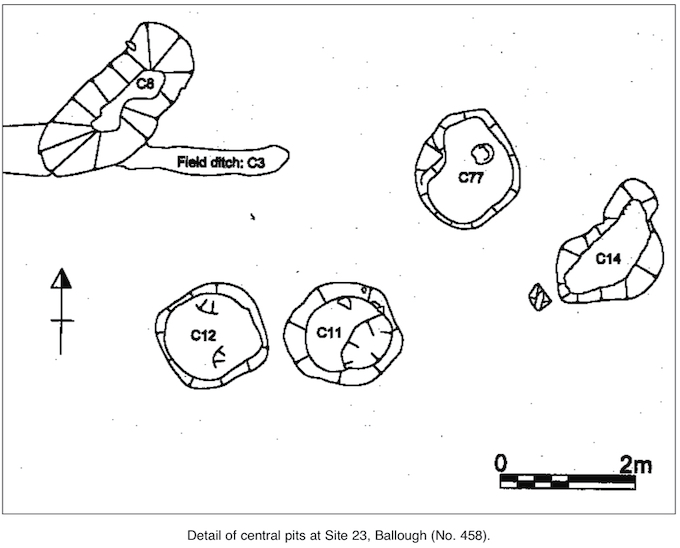2002:0457 - BALLOUGH (Site 17), Dublin
County: Dublin
Site name: BALLOUGH (Site 17)
Sites and Monuments Record No.: N/A
Licence number: 02E0078
Author: Robert M. Chapple, for Valerie J. Keeley Ltd.
Author/Organisation Address: 19 Irwin Drive, Belfast BT4 3AR
Site type: Field system
Period/Dating: Medieval (AD 400-AD 1600)
ITM: E 718738m, N 755113m
Latitude, Longitude (decimal degrees): 53.532541, -6.208888
The site was discovered during monitoring of topsoil-stripping on the line of the Northern Motorway (Phase II, Lissenhall–Balbriggan Bypass), Co. Dublin, for Fingal County Council, carried out by Patricia Lynch for Valerie J. Keeley Ltd (see No. 450, Excavations 2002, 00E0953 ext.). The area investigated covered c. 452.87m2 and lay c. 2.5km west-north-west of Lusk and c. 8km south-west of Skerries, in generally flat to gently rolling countryside (c. 22.5m OD). The site itself sloped gently to the north-east and lay in an area intended as part of the road realignment between Colecot Lane and a flyover bridge over the main take of the Lissenhall–Balbriggan Bypass.
The central feature in the site was a linear field ditch (C7) with steep, concave sides and a concave base (42.88m+ by 1.42m by 0.7m). This feature ran from east to west across the site, continuing beyond the area available for excavation at both ends. C7 cut the subsoil and contained nineteen fills. This feature was investigated using a series of fourteen box-sections. From these fills six pieces of animal bone (burnt and unburnt) were recovered, along with over 100 sherds of medieval and post-medieval pottery. Wet sieving of fill F68 from the C7 ditch allowed the recovery of blackberry/raspberry seeds. Although these have yet to be formally identified, their presence on medieval sites is frequently indicative of cesspit material. Wet sieving of samples from fills F52 and F55 produced quantities of carbonised grain (species as yet unidentified). All artefacts and organic materials were confined to the eastern end of the C7 ditch. The western end of this ditch was sterile, being filled with a succession of pale grey silts and clays, indicative of fluvial deposition.
C24 was a sub-oval spread with very shallow sides and a concave base (0.93m by 0.45m by 0.13m); its fill produced three sherds of medieval pottery. C60 was a sub-oval spread with gradually sloping sides and a concave base (0.7m by 0.4m by 0.08m); its fill produced one sherd of medieval pottery. C25, an oblong pit with convex sides and a flat base (1.13m by 0.66m by 0.18m), contained one fill. Although this pit did not produce any artefacts or dating evidence, its similar morphology and location close to spreads C24 and C60 may indicate a similarly medieval date.
In essence, the archaeological core of Site 17, Ballough, was a single field ditch of medieval date. Although no direct evidence of settlement was discovered, there remains a strong likelihood that the recovered pottery derived from an adjacent source. In the light of this excavation, one strong area of possibility is that to the north of the excavated site, between the road realignment and the flyover bridge for the motorway. Unfortunately, this area was not part of the road-take and was thus not available for excavation.

